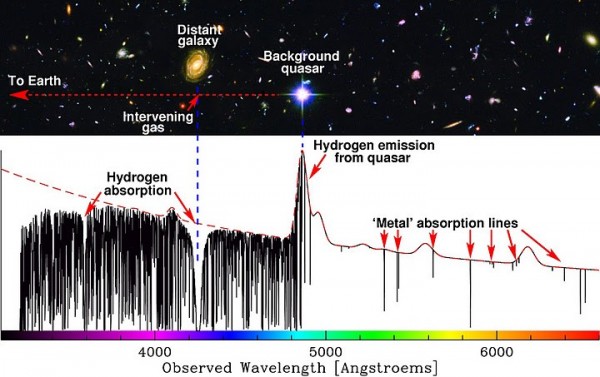“Science casts a long black shadow back over who we think we are, and where it falls the temperature falls with it. Its touch is chilly and unforgiving.” -Richard K. Morgan
Here on Earth, when we're dealing with normal matter, it's relatively easy to measure the temperature of something. Even if you don't have a thermometer handy, if you can do something like measure the speed/kinetic motion of the particles in there, you can easily figure out what the temperature of a system is.
But things are a lot more complicated -- and elusive -- if you want to measure the temperature of something you can't even directly detect, like dark matter. But if you're clever in your methods, this task not only is possible, but there are multiple different ways to go about measuring it!



So the more detailed write up was informative, thank you. I'm missing something on the Lyman-Alpha data though. Clearly since DM does not affect the Lyman-alpha directly because of no electromagnetic interactions between dark and regular matter so any impact would be due to the gravitational interaction between DM adn norma matter. You say "if the dark matter were warmer, the depths of those lines would be suppressed by a specific amount, while if the dark matter was colder than a certain amount, those absorption lines would be up to 100% efficient". Wouldn't it also be true that the absorption lines would be 100% efficient if there were no dark matter at all?
Gravity only travels at the speed of light? Not realy. First off, gravity is not moving at all. (at least not relative to its mass source) I assume you did not mean that the mass accounting for that gravity moves only at the speed of light. Because we can see several masses move at higher speeds relative to us. The thing is that you still use pre-Einstein terms an give them after-Einstein propertys.
So again. Mass is bending spacetime. But, there is no known limit to the speed wich timespace can be bended. There for, if you instantly take out a mass, timespace will be bended instantly. If you instantly take out the sun, earth will notice this instantly. It is ofcourse impossible to do so. You can't move a mass at speeds higher then the speed of light. And you can certainly not (for other reasons) make a mass decay so fast. Therfore you can also not put a mass instanly on some place so you can speak of a wave of gravity that walks at the speed of light.
Nonetheless, there is a speed limit in this system. The speed limit that information can travel. Let me try to explain this with a illustration. The changes gooing on in spacetime act like a Penrose tiling. When you look at a piece of spacetime, you can compare that with a full Penrose tiling in place. When 1 tile somewhere in de center is changing there will be a change in the outher borders too. So if you change one tile, you have to change a lot of other tiles so the whole tiling is fitting again. This wil take you time. And the time you take to lay piece by piece will reduce the speed to complete the whole tiling. The rules for the tiling stand for the rules in physics. The laws. Thats also why time flows forward. The tile can only be fitting in 1 way because of the rules that make up the tiling. In the same way the state of the universe can only be 1 state because of the physics laws.
Now when u look at a spacetime system, there will be many many changes. And they all will be corrected in other places in spacetime to force the spacetime to play by the rules. Therefor there will be two speed limits. There is a limit on the speed that the information (the changes) can travel. And there is a limit on the speed that the changes (the information) can happen.
Really, dive into the Penrose tiling and you just see the solutions, jet you can't explain the fully. But at least you see them.
I am very aware of my dumb english, very sorry to put you up with that.
Now, lets build an example. Lets assume the speed of light is very slow. So slow that the light of the sun did not reach us yet. But we can see Venus due the effects of the expanding univers. Now. If we both lived in that system. You would would conclude that there is dark matter to account for the speeds you see. I would say that the speed of light is to slow to make an conclusion.
Now lets take an other example. Lets assume the speed of light is what it is today. The only difference is that we can look deeper in space and time. Now you conclude that ther has to be dark matter to explain the speeds you see. I still say that the speed of light is to slow to make that sort of conclusions.
I would also say that the penrose tiling includes the whole universe on the observers place we stand now. Or, the spacetime we can not see because we can not look deep enough in space and time is here, now, at this place we stand. The whole spacetime is out there and in here.
I have a question, probably due to lack of study, but your mention of "...metric expansion of space..." brought it to mind (and two weeks ago I had the impression that inflation was after bang and not before bang), so, on the large scale, are the galaxies moving away from us through space or are they actually fixed in space and appear to be moving away due to the expansion of space itself?
@4: both occur, but the former motion is variable and local. In other words, some galaxies are moving away from us through space, while some are not and some are actually moving towards us.
The expansion's impact is small or negligible on a local scale. If some galaxy has acquired momentum in some direction, the metric expansion of the universe isn't going to stop it from moving in that direction.
@5: Thank you for the explanation; I understand.
Hie Ethan
A serous alternative to CDM and an explanation of Dark Energy can be found in this paper http://www.worldscientific.com/doi/abs/10.1142/S0219887814500595 Mondian behaviour in galaxies begins when the baryonic energy density is equal to the dark energy density. Unfortunately the paper is behind a paywall. If you have no access to it I can send you a preprint .
I wonder whether the DM is just a gravitational resonance between quantum vacuum fluctuations and Higgs field initiated by the presence of normal matter according to general relativity.
From black hole evaporation we know that the gravity interacts with vacuum fluctuations. We also know that DM creates a halo around normal matter, but I haven't seen any direct interaction between real astronomical object and pure DM object (i.e. real object orbiting a pure DM object) .
I didn`t find any physical contradiction to my assumption, nor I understand enough math to find out myself, so I ask Ethan.